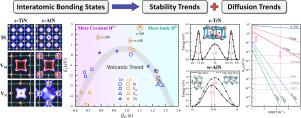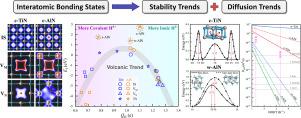Chemical-bonding and lattice-deformation mechanisms unifying the stability and diffusion trends of hydrogen in TiN and AlN polymorphs
IF 8.3
1区 材料科学
Q1 MATERIALS SCIENCE, MULTIDISCIPLINARY
引用次数: 0
Abstract
The continuous development of hydrogen-permeation barriers (HPB) based on metal nitrides highly desires a generic unification of the key thermodynamic and kinetic mechanisms therein. This work employs first-principles calculations to study the stability and diffusion trends of H impurity in the rock-salt, wurtzite, and sphalerite phases of the prototypical TiN and AlN. The formation energies () of H at various interstitial and vacant sites in these nitrides are calculated, and the underlying chemical-bonding and lattice-deformation mechanisms are self-consistently revealed by the systematic structual, energetic, and electronic-structure analyses. This leads to the discovery of a generic volcanic trend of in terms of the electron number on H (), which well portrays how the covalent-ionic H–N and H–metal bondings determine its stability in different atomistic environments. Then, the kinetic properties (e.g., potential barriers, diffusion coefficients, and isotope effects) of interstitial H in these nitrides are calculated, where the volcanic – relationship is applied to better understand the joint contributions of chemical bonding and lattice deformation. Finally, the revealed mechanisms and volcanic – relationship are generalized to successfully describe the behaviors of H in some important grain boundaries of c-TiN and c-AlN, including the twin frequently observed in c-TiN and the twin prototypical to many rock-salt materials. The widely varying hydrogen permeabilities measured in experiment on many nitride coatings are successfully explained, inspiring more useful chemical principles to guide the design of HPB coatings facing harsh environments with long-term reliability.


化学键和晶格变形机制统一了氢在 TiN 和 AlN 多晶体中的稳定性和扩散趋势
基于金属氮化物的渗氢屏障(HPB)的不断发展迫切需要对其中的关键热力学和动力学机制进行一般性的统一。本研究采用第一性原理计算方法,研究了 H 杂质在原型 TiN 和 AlN 的岩盐相、闪锌矿相和闪锌矿相中的稳定性和扩散趋势。通过系统的结构、能量和电子结构分析,计算了 H 在这些氮化物中不同间隙和空位的形成能 (Ef),并自洽地揭示了潜在的化学键和晶格变形机制。这导致发现了以 H 上电子数(QH)表示的 Ef 的一般火山趋势,很好地描绘了共价离子 H-N 键和 H 金属键如何决定其在不同原子环境中的稳定性。然后,计算了这些氮化物中间隙 H 的动力学特性(如势垒、扩散系数和同位素效应),并应用火山 Ef-QH 关系来更好地理解化学键和晶格变形的共同作用。最后,将所揭示的机制和火山Ef-QH关系加以推广,成功地描述了氢在c-TiN和c-AlN的一些重要晶界中的行为,包括在c-TiN中经常观察到的Σ3{112}〈110〉孪晶和许多岩盐材料中典型的Σ5{210}〈001〉孪晶。我们成功地解释了实验中在许多氮化物涂层上测量到的差异很大的氢渗透率,从而启发了更有用的化学原理,以指导面对恶劣环境的高纯度氮化硼涂层的设计,并确保其长期可靠性。
本文章由计算机程序翻译,如有差异,请以英文原文为准。
求助全文
约1分钟内获得全文
求助全文
来源期刊

Acta Materialia
工程技术-材料科学:综合
CiteScore
16.10
自引率
8.50%
发文量
801
审稿时长
53 days
期刊介绍:
Acta Materialia serves as a platform for publishing full-length, original papers and commissioned overviews that contribute to a profound understanding of the correlation between the processing, structure, and properties of inorganic materials. The journal seeks papers with high impact potential or those that significantly propel the field forward. The scope includes the atomic and molecular arrangements, chemical and electronic structures, and microstructure of materials, focusing on their mechanical or functional behavior across all length scales, including nanostructures.
 求助内容:
求助内容: 应助结果提醒方式:
应助结果提醒方式:


